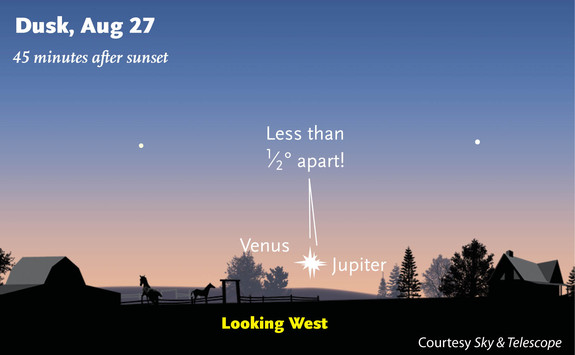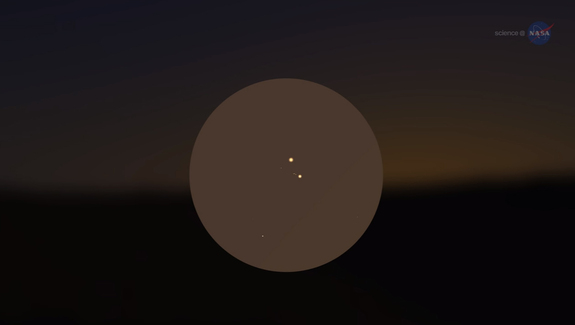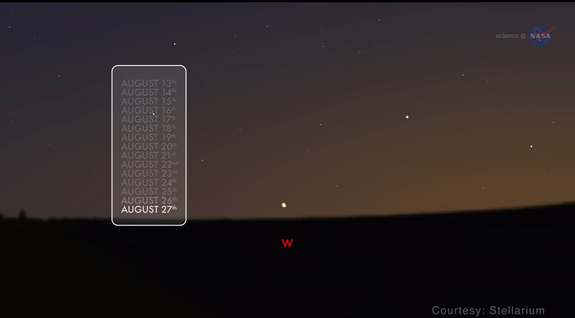The two brightest planets in the night sky, Venus and Jupiter , will dance together on Aug. 27, 2016, in their closest encounter until 2065. Here’s how to see them.
On Saturday, Aug. 27, skywatchers will get a chance to see Venus and Jupiter paired in an extremely close configuration. For viewers in parts of the United States and Canada, the two planets will almost appear to touch, caught passing each other like two ships in the twilight.
For much of 2016, Jupiter has been the dominant planet in the evening sky, shining like a brilliant silvery “star” for much of the night. But over the past couple of months, it has been dropping noticeably lower in the western sky and now can be glimpsed only for a short while in the post-sunset glow. Very soon, Jupiter will disappear into the glare of the sun as it makes the transition from the evening sky to the morning sky. [Venus And Jupiter Conjunction Can Be Seen With Naked Eye | Video ]
In contrast to Jupiter, Venus has been difficult, if not impossible, for most people to see in 2016, as it has been positioned very near to the sun. It began creeping out of the bright glow of the sun in mid-July and continues to emerge ever so slowly into view during August. When the two planets pass each other on Aug. 27, it will be, in a way, the passing of the torch; Jupiter will relinquish the title of “evening star” to Venus. As Jupiter is going down, Venus is gradually coming up. And by later this year, Venus will be a dazzling object in the west-southwest sky once it becomes fully dark.

Venus and Jupiter will share a rare super close encounter in the night sky on Aug. 27, 2017 during a conjunction that is also known as an appulse. Such a close celestial rendezvous between the two planets won’t occur again until 2065.
Credit: Sky & Telescope diagram
Where and when to see them
Before the 27th, scout out a location that can provide you with a clear and unobstructed view of the western sky. The two planets will lie only 5 degrees above the western horizon about 30 minutes after sunset in bright twilight; brighter Venus will shine just above Jupiter. You can judge how high above the horizon 5 degrees is by making a fist and holding it out at arm’s length. Place the bottom of your fist on the horizon, and the top part is 10 degrees.
So the two planets will be only half that width above the western horizon a half hour after sundown. If the sky is hazy, you might also want to scan the horizon with binoculars to help you pick them out. Be sure to take a look — it will take until 2065 to catch an approach closer than this.

A preview of Venus and Jupiter during an extremely close encounter, which will take place just after sunset on Aug. 27, 2016.
Credit: Science@NASA
Conjunction or appulse?
Most astronomical calendars and almanacs would refer to this pairing of the two brightest planets as a conjunction. Strictly speaking, a conjunction is when two astronomical objects are either at the same right ascension (hour angle as plotted on a star atlas) or the same ecliptic longitude, as observed from Earth.
A conjunction between Venus and Jupiter, in and of itself, is not a rare event; it occurs about eight to 12 times per decade, on average. Usually, in such cases, the smallest angular distance between these two planets is about a degree or two, with 1 degree equal to the width of two full moons.

This simulated image shows the separation between Venus and Jupiter on Aug. 27, 2016. The two planets look like one bright spot just above the horizon. For some viewers, the planets will be separated by no more than 1/15th of a degree on the sky.
Credit: Science@NASA
But the Aug. 27 occurrence will be a rather special case, and better fits the definition of an appulse. An appulse is an astronomical term that refers to a very close approach of one celestial object to another. It’s related to a conjunction, but the definitions differ in detail. Whereas a conjunction occurs at the instant the two bodies have the same right ascension or the same ecliptic longitude, an appulse occurs when the separation between two bodies is at an absolute minimum. In general, the precise time of an appulse will be different from that of a conjunction.
Indeed, the 2016 Observer’s Handbook of the Royal Astronomical Society of Canada notes that on Aug. 27, Venus and Jupiter will be in conjunction in right ascension at 2200 GMT (6 p.m. EDT), with Venus passing 0.1 degrees north of Jupiter. But that’s not the moment when the two planets are closest to each other. According to Belgian astronomical calculator Jean Meeus, that moment will come 31 minutes later, at 2231 GMT (6:31 p.m. EDT). And the separation will be measured not in angular degrees but in arc minutes. Sixty arc minutes equals 1 degree. From eastern North America, the two planets will appear closest — separated by just 4 arc minutes, or 0.067 degrees (only about one-eighth the apparent width of the moon). [Celestial Snapshots of My Favorite Conjunctions ]
How close?
To get a better idea of how close this is, check out the northwest sky as soon as it gets dark, and locate the seven stars of the Big Dipper . Look at the middle star in the handle of the Dipper; that’s Mizar. With normal eyesight, you should be able to make out a fainter star just above Mizar, shining about one-fifth as brightly. That’s Alcor. The ancient Arabs considered it to be a test of good eyesight. Mizar and Alcor are separated by 12 arc minutes. Remember that point when you see them in the sky. Also remember that at the moment of their appulse on the 27th, the distance between Venus and Jupiter will be only one-third that which separates Mizar from Alcor! Along the Atlantic Seaboard, closest approach will come less than 2 hours before sunset. That 4-arc-minute width will increase slightly, to 5 arc minutes by local sunset. By the time the sun sets for western North America, the separation will have widened to 11 arc minutes, or 0.183 degrees. That’s still closer than Mizar and Alcor by 1 arc minute, or 0.017 degrees.
If the skies are clear, I expect a bevy of phone inquiries to media outlets and police stations regarding “a pair of weird unidentified flying objects hovering very low in the western twilight sky.” Try to see this if you can, because it is very infrequent that these two planets approach each other this closely. In fact, the next opportunity will not come until Nov. 22, 2065, when these two planets will appear to merge into a single, dazzling point of light!
Editor’s note: If you catch a photo of Venus and Jupiter’s close encounter that you’d like to share with Space.com and our news partners for a possible story or image gallery, please contact managing editor Tariq Malik at spacephotos@space.com.
Joe Rao serves as an instructor and guest lecturer at New York’s Hayden Planetarium. He writes about astronomy for Natural History magazine, the Farmer’s Almanac and other publications, and he is also an on-camera meteorologist for News 12 Westchester, New York. Follow us @Spacedotcom , Facebook and Google+ . Original article on Space.com .
Comments are closed.